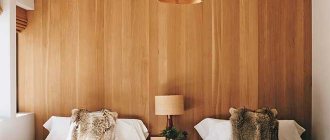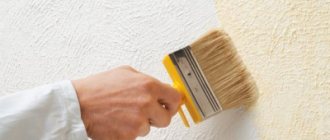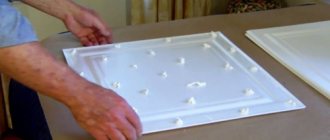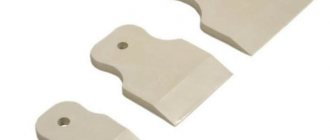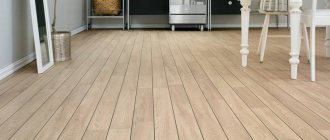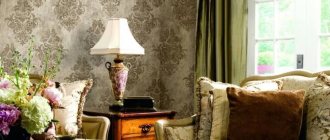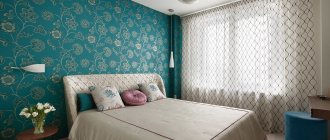The presented building material has become widespread in the design of interior walls of various rooms. Thanks to its special characteristics and practical properties, it has won the sympathy of homeowners and earned many positive reviews. Cork wall panels recreate attractive images in the interior; they are used to line kitchens, living rooms, children's rooms and bathrooms. Their performance properties allow the canvas to be used in any room, they look great and maintain their original appearance for a long time, up to 15 years or more, they do not tend to age. They are also characterized by: retaining heat energy in rooms and the distinctive feature of isolating internal and external sounds.
How to glue cork panels to walls?
In practice, gluing cork to walls is not at all difficult. Therefore, even a non-construction professional can handle this manipulation. At the same time, the cork coating itself is characterized by excellent sound-proofing and heat-insulating properties combined with excellent resistance to mechanical damage. In addition, it does not rot, does not burn, and is not afraid of moisture, which is also important. Don’t forget that any modern cork panel is specially impregnated with varnish or wax, which only adds to its durability and water-repellent properties.
Brief description of types of cork materials
- No base. These products are quite dense, but at the same time they are characterized by low fracture strength. It is better to entrust the work of covering walls with cork wallpaper to a specialist.
- With a base. It is made of paper, so the process of fixing the canvases is much simpler. In principle, it is quite possible to cope with the work alone. The process is not much different from the technology of gluing wallpaper from other materials.
Tile
A composite material consisting of pressed cork and a coating (water-repellent film). The advantage is that it is much easier to lay and adjust individual segments than canvases.
Pros and cons of cork panels
Wall decoration with cork panels is gaining popularity, as the material has excellent technical characteristics and advantages. They are:
- Cork is 100% natural material, does not emit toxic substances and does not harm human health.
- Has the ability to retain heat.
- The panel is soundproof and does not require additional finishing.
- Will not absorb odors. Even after long-term use, no accumulation of aromas is observed.
- They are not afraid of the influence of household chemicals.
- Cork is not afraid of water and can be used in damp areas. But still, prolonged and direct exposure to water is undesirable.
- The surface is matte and non-slip. This is especially true if cork is used as a floor covering.
- Decorative finishing does not rust or rot.
- Fire protection.
- Rot, mold and mildew will not form on the surface, since the cork has anti-condensation properties.
- The material is light and soft, the dent is restored from an impact. If a child falls, there is less risk of injury; walking through traffic has a positive effect on the vertebra.
- The material is antistatic, does not attract dust, and is hypoallergenic.
- Ease of installation work.
- Long service life.
- Durability and reliability.
The finishing also has disadvantages:
- Since the material is natural, its cost is appropriate. Wallpaper or decorative putty will cost less.
- If you use floor panels, the furniture may leave dents on the surface.
- No resistance to abrasives such as sand, wire brush, etc.
- If the room has high humidity, then prolonged exposure to water can lead to swelling of the cork panels.
- Using cork in the interior is not something sophisticated. The decorative qualities of cork are mediocre. But, you can create an ethnic or eco style.
The cork is waterproof. This property allows it to be used to decorate a bathhouse or sauna. It is only important to ensure that moisture does not linger on the surface.
general information
- They frame them; ceilings, walls, floors, highlight decorative elements; partitions, columns, interior structures, arches, landings and entrance openings are suitable both for completely covering the base and for decorating certain fragments, expanding their aesthetic possibilities when creating a design. Their peculiarity in the interior is emphasized by the formation of a cozy space, thanks to the warm shades of wood and the feeling of soft relief upon tactile contact. They create a pleasant indoor environment. It is also worth highlighting the fact that excellent noise insulation and reduction of shock vibrations are achieved. The density of the sheet and their layered structure cope with high levels of household noise and the flow of vibration waves, naturally blocking their penetration or propagation in space from an internal source. As a result, the use of the material will give a rich look and quiet living.
- Decorative cork panels also have a lot of other positive differences; the use of natural components in production, forming the content of the composition only from natural elements; increased resistance to environmental influences and any climatic conditions, expanding the scope of application and highlighting durability; ease of carrying out the necessary maintenance of the coating, including wet cleaning; the versatility of the canvas is manifested during installation, since it is permissible to lay it on any base, brick, plaster, wood, varnished and painted structures, and even metal. Let's look at their structure and variety options in more detail, why they are valued, how installation is carried out and how to properly glue them to the walls. First, let's get acquainted with the modification of all coatings where cork is present.
What cork coverings exist, their classification.
Let us highlight some varieties, their characteristics and general information.
- Tiles, panels, cork panels for walls. The most practical and expensive representatives, about which full information will be presented in the main content of the article. The structure is multi-layered, entirely made of cork, the decorative part is made of veneer. The sizes are different, with right angles.
- The substrate, technical cork, agglomerate, is most often used as an additional insulating and sound-absorbing element, but there are options that can be used for finishing. Single-layer, their disadvantage when covering walls is that they can crumble, since they do not have decorative treatment, and they will have to be varnished. Cheaper, limited selection.
- Rolled cork coverings. Similar to the structure of panels, they consist entirely of wood material, multi-layered, the outer part is made of veneer. Designed for finishing.
- Liquid plug. Most often used for finishing the external sides of a building, it is also used indoors. Available in any color, red, yellow, blue, etc. It is laid using a sprayer in several layers to form a monolithic surface.
- Wallpaper. The most affordable of all varieties, due to price and installation method. They are produced on different bases, paper or non-woven fabric, with or without the addition of vinyl, on which cork shavings are applied in the form of veneer. Decorative properties are not inferior to other varieties. They are applied like regular wallpaper and come in standard sizes. To learn more about cork wallpaper, follow this link.
- Models are also produced from MDF, the marking stands for finely dispersed fraction, consisting of shavings formed from wood processing, granulated and crushed cork material is applied to this panel. They have the shape of large rectangular slabs in different parameters, with a locking design for interconnection. A similar structure is used to produce canvases based on chipboard and PVC, which are extremely rare and can be divided into moisture-resistant and non-moisture-resistant, depending on the foundation foundation.
All presented varieties are endowed with similar aesthetic properties, but differ in basic performance characteristics.
What influences pricing?
- The first is the material itself. Its extraction takes place in southern countries, and only tree bark is used, which grows for several years. Primary raw materials are used, these are whole sheets of bark, having a higher value, and secondary, formed from wood processing, in the form of chips and sawdust.
- The structure of the canvas and the complexity of production. Multi-layering, thickness, adding decorative fillers, using crumbs or solid sheet elements made of cork.
- Brand, manufacturer and transportation of the product. The main producers are foreign countries, Spain, Portugal, Italy, France.
For these three main reasons, the high cost of products with proven quality and excellent properties is formed.
Also read: Types of drywall and its characteristics
In this article we will get acquainted with the modification of panels and their capabilities.
How to choose cork panels
The criteria for choosing cork panels for walls are determined by the installation area and intended purpose. Before purchasing, consider a few important points:
- The installation location of cork panels affects the thickness of the material. For a bedroom or children's room, choose no thinner than 4 mm; such panels will successfully cope with sound insulation and heat retention.
- If you plan to install cork panels in the bathroom, look for an option with a waterproof base.
- To decorate walls in a living room or office, a panel thickness of 2 mm is sufficient. There is no point in purchasing thicker material, and the cost will differ several times.
- Decide which decorative technique is preferable for the room: clean cork without inclusions, or with the addition of decorative elements.
- Pay attention to the cost of panels in terms of the required quantity. If you want to save money, choose panels that contain cork veneer and chips; by adding chips, the panels will be cheaper, but will not be inferior in quality.
- Choose the size of cork panels for the walls, it depends on the dimensions of the room. For a small room, square panels with a side of 60 cm are suitable; choose a larger size to decorate a spacious room.
DIY wall decoration with cork
Start by choosing your coverage . Most often, cork wallpaper and cork tiles are glued to the walls. These coatings look very beautiful, but working with each of them has its own characteristics.
Cork wallpaper , which has a paper base, must be glued together by two people, since after applying special glue, the panels get wet and can tear during the work if there is no assistant nearby. It would be correct to do this: one applies the glue, the second helps to level the panels. The process is the same as when gluing regular wallpaper.
Baseless cork wallpaper is denser, but at the same time, fragile. The roll coating is quite difficult to glue. It is better to entrust this work to professionals.
For those who decide to decorate the walls with cork themselves, the third option is more suitable - cork tiles . This material is a compressed cork that is sanded and has a special moisture-resistant coating. Thickness is 3-4mm, sometimes cork sheets with greater thickness are used. There are one- and two-layer tiles.
Why tile? Main advantages of modular tiles :
- Convenient sizes . Tiles made from this natural material are produced in sizes 300x300mm, 600x600mm. It is much easier to hold and work with than thick roll coverings or wet panels of wallpaper;
- The presence of a protective coating of wax or varnish . Cork sheets can be used to decorate bathrooms, kitchens, and rooms where there is sufficient humidity.
And here is an article about cork flooring manufacturers.
Which laminate is better for finishing walls?
A very difficult task faces the consumer when choosing a laminate. Here it is necessary to solve several problems simultaneously:
- choose the texture and color of the finishing material to match the style of the interior;
- ensure that the laminate regulates the space and geometry of the room;
- at the same time, it performed its main function - finishing;
- The cost was affordable for the family budget.
When choosing a material for finishing a room, first of all you need to take into account financial capabilities. However, in the case of laminate for walls, everything is much simpler: there are many options to choose from, but they are all identical in quality and durability - this material does not experience any stress on the walls.
Therefore, class 21 slats with a thickness of 6 mm (produced specifically for walls) will last as long as class 33 products with a thickness of 12 mm. Therefore, there is no need to overpay for a higher quality finishing material if the end result is the same.
Attention: lamellas of class 21-23 do not have locks and are attached only with glue.
The next thing you need to pay attention to is how to attach the slats to the wall. If it is flat or sheathed with sheets of OSB or plasterboard, then the best option is adhesive, without a tongue-and-groove system. This is the simplest installation technology: the slats are attached to the wall with “liquid nails” or special types of glue.
Attention: laminate thicker than 6 mm cannot be glued to glued plasterboard - the entire system may collapse under the weight of the finish. The problem is solved by additionally fastening the gypsum board to the wall with self-tapping screws (with self-tapping dowels if the base of the wall is concrete).
The issue with uneven walls is resolved differently. They can be plastered, but it is expensive, messy and time consuming. But you can make everything much simpler: install a wooden frame made of slats (plywood), on which the finishing will be attached. In this case, two types of fastening are suitable: tongue-and-groove and click.
The tongue-and-groove method of fastening lamellas is based on special devices: clamps, which are attached to the slats and hold the laminate by the ridges, without interfering with closing the connecting lock between adjacent panels.
The click method of fastening the slats to each other (when the lock is clicked, a characteristic sound is heard - that’s why it’s clicky) is based on more modern locks.
The assembled wall panel is attached to the wall surface with self-tapping screws (along the perimeter), decorative nails (evenly along the entire wall), or glue. The nail heads are sealed with special pencils, and the heads of the hardware are hidden by the plinth and side profiles. After solving technical issues, aesthetic ones are resolved. For each room in the apartment, designers have their own recommendations.
Living room
The living room, or, in the old way, the hall, is the place where the owners demonstrate their status. Therefore, finishing all the walls with laminate will look ridiculous. Partial wall covering with lamellas is encouraged here. The combination of aged laminate with stone, decorative plaster or fabrics looks rich.
Light, cool shades are selected for the living room on the south side of the apartment and warm ones on the north side. The slats look impressive near the fireplace and in the area where the TV is located, especially if it hangs on the wall (in this case, the laminate finish has another function: decorative - all the wires going to the TV are hidden). The living room is the type of room where there are no restrictions on the imagination of the designer or owners.
Bedroom
The most acceptable solution for the bedroom is to decorate the wall at the head of the bed with laminate. The lamellas imitating natural wood look very rich and respectable. Textiles of the same shades look harmonious with this type of decoration. Sconces or paintings attached to a wall finished with laminate will add charm to the room.
Hallway
According to the tradition that arose in the early 60s of the last century, the hallway in Khrushchev-era buildings was upholstered with clapboard, which is practical and beautiful. Therefore, “God himself ordered” to decorate this part of the room with laminate, as people say.
In the corridor, with the help of finishing material, you can highlight different zones using the texture and colors of the lamellas. They cover either one wall or the lower part of all walls, and try gluing wallpaper or putting decorative plaster on the upper part. Both options look very impressive.
Kitchen
Laying laminate flooring on the wall in the kitchen has more practical than aesthetic value. Here the work area and eating area get very dirty, but the slats are easy to clean. Moreover, they are much cheaper than tiles. At the same time, laminate can imitate various finishing materials: cork, stone, wood, tile.
The only thing you need to remember is that moisture-resistant laminate of class 31-33 is purchased for the kitchen.
Bathroom
In the bathroom, all finishing materials are subject to extreme exposure: temperature changes and humidity fluctuations. Under these conditions, most experts will advise abandoning the idea of laminate walls in this room.
But even for such conditions there is a laminate - waterproof lamellas of class 31-32 with a thickness of at least 8 mm (attention: waterproof, not moisture resistant). Practice shows that it can withstand the existing extreme conditions. How long this will continue is still unknown, there are no statistics.
Loggia and bankon
Finishing the walls with laminate in the loggia allows you to get an additional seating area. Attempts to lay laminate flooring on the walls on the balcony often lead to negative results even after insulating this part of the apartment - in winter the slats become unusable.
We recommend: Coal combustion temperature
Glue characteristics
Cork is the bark of a cork tree that is removed from it from time to time. This material has a long service life, is resistant to moisture, and has excellent sound insulation characteristics.
Despite its many advantages, cork is a fragile and expensive material. If you manage to become its owner, then you should think about a high-quality and heat-resistant adhesive composition (cork retains heat excellently).
There are currently two types of glue designed to work with cork:
- Universal acrylic.
- A contact adhesive composition that is used to treat both surfaces being joined (most often used).
Important! Many people are interested in whether it is possible to glue a cork with PVA glue. Such a composition is not suitable, since the material absorbs liquid, as a result of which it swells and deforms.
Main characteristics of contact adhesive:
- unusually strong connection between the wall and the cork covering;
- increased resistance to moisture;
- resistance to acids and alkalis;
- resistance to high and low temperatures.
Instructions . How firmly the surfaces will be connected depends on time: it is enough to press them together for 20 seconds; with longer pressing, the connection will be stronger. For high-quality adhesion, the glue must be applied to dry and clean walls, the air temperature should be from +15° C, and the humidity should be below 75%.
Do-it-yourself installation of cork panels in a private house
Despite the listed strengths of this facing material, it is not able to remove obvious deformations and other defects of the walls. This is why the surface of the walls must be carefully prepared before gluing cork panels. To do this, it is necessary, first of all, to properly level the surface of the walls. The latter is important for the reasons that cork panels are mounted on glue and the required level of adhesion between the base and the cork can only be achieved if the base has a smooth and clean base. The surface of the walls also needs to be primed.
See also: Why are houses built without balconies?
You need to prepare not only the walls, but also the cork panels - for this you need to leave them in the room where the installation will be carried out. It is important to remove the packaging - you need to leave the panels in the room for at least fifty hours. You can achieve the necessary adhesion on painted walls by treating them with a fine-grained plaster mortar - in this case, good adhesion is guaranteed. Cork wall panels for interior decoration will hold tightly and reliably.
Tool kit for installing cork panels
- Dishes for adhesive composition
- Ruler
- Contact glue only
- Square
- Electric jigsaw prepared for working with wood
- Plumb line for marking
- Pencil for marking
The glue will need to be mixed and diluted in minimal quantities at an air temperature of about 10 degrees Celsius. The mixture is diluted as quickly as possible - it quickly loses the necessary properties. When installing cork panels, a maximum moisture level of the base of the walls is allowed at about three percent. So, the finishing begins.
Types of cork covering
Cork is glued to walls made of a wide variety of materials. There are the following types of coating: rolls, wallpaper, liquid wallpaper, segments, tiles.
Wall
Each cork panel has a tongue and groove design, making them easy to install. But the cork covering is glued directly to the wall, and not to the sheathing.
Ceiling
Most often, the ceiling material is white, but there may also be others, for example, pastel colors. Panels (slabs) of small thickness. For finishing rooms with a high degree of air humidity, it is recommended to purchase cork slabs that are treated with wax. But if the material is ordinary, then one layer of colorless varnish is applied to the ceiling tiles.
Cork ceilings do not deform due to sudden temperature fluctuations and increased humidity.
Rolled decorative cork
Rolled decorative cork is made of 2 layers: a substrate - medium-sized and compressed cork chips, and a layer of cork veneer is applied on top.
This room decoration is created without the use of synthetic binders. The material has no finishing, which is why, after gluing it to the walls, it is covered with heated wax or varnish. Rolled cork is very thin - 1.2-2 mm, so it is elastic and easy to combine with wallpaper. It does not swell with water and does not peel off, which is why it is excellent for rooms with high air humidity.
Another advantage of the material is that there are no horizontal seams when gluing, the result is an absolutely uniform pattern.
Liquid coating
It is made from 96% natural bark chips and 4% acrylic based binder. It has a large number of tiny pores saturated with nitrogen and oxygen, suberin juice and resins are present, so it is waterproof.
Cork wallpaper in rolls in the interior
Cork wallpaper is created as follows: a paper canvas is treated with colorless or varnished in any shade, covered with thin agglomerated veneer (up to 1 mm), leaving unfilled spaces. Cork wallpaper has many pores, which is why they do not allow sound and heat to pass through. They are very light, but elastic, so they can easily withstand a variety of loads. They are antistatic, do not collect dust, and have antibacterial properties. We sell cork wallpaper in natural colors and with various colored inclusions. As a rule, rolls are sold 10 m long. The material is very thin - 3 mm. And its width: 300x600 mm or 300x1000 mm. They can retain their structure and color on the wall for up to 10 years.
Cork tiles for interior decoration
Cork slabs are created by grinding the bark of a cork oak tree into pieces of 0.2-8 mm.
Plates can be made of 1 or 2 layers. When preparing slabs from 1 layer, the granulated cork is pressed, then wax is applied to it to give greater strength. As a rule, the substrate is quite thin, only 2 mm. When creating slabs of 2 layers, first coat the main layer of pressed cork with glue made from natural substances, then attach the cork veneer.
Usually the base of the slab is painted in some color. Standard wall cork tiles: 3x300x300 mm or 3x600x300 mm (thickness x length x width).
Types of panels
The most common model among cork products is panels, moreover, it is endowed with the best properties, and this is not without reason. They have no protrusions for joining, are laid end-to-end on walls, and come on a self-adhesive base, offering tile or sheet options. Among them, specifically panels, two main types can be distinguished:
- This is a model of different sizes, square or rectangular, with a different range of colors and texture relief.
Options are produced with imitation of other coatings, stone, brick, etc. With a smooth layer, large and small relief, multi-colored, with a three-dimensional image. For example; texture map of the world, one of the most common, or simply conveying the appearance of wood cork. Used for full and partial coverage of surfaces. - A decorative panel, which is offered in a large size, unlike the first option, and has an artistic image on the front part. They come as a single canvas, these are sheet versions, or consisting of several smaller parts, in tiled form.
Ornaments and illustrations are provided in a rich assortment and in different colors; the image of the outer layer can be smooth or embossed. They are used as a decorative feature, often to partially fill the surface, attracting all the emphasis to their image.
These models have common characteristic features and are produced using the same technology, with a layered structure. The differences are only in appearance and dimensional data, they do not have a dividing classification, and the panel is a type of panel. Cork wall panels for interior decoration are an excellent way to decorate vertical surfaces with natural material, without synthetic additives.
Structure
The panels are made entirely from cork through a multi-stage development process. The single structure consists of layers, a base and a decorative external veneer. All are made from the natural composition of balsa wood and oak bark, for which the panels have received special value, because the fashion for natural products is only growing.
- The mold is made in the form of rectangular and square sheets, with different ratios of length and width, and due to their size they are very convenient to attach during repairs. The microstructure itself has a multilayer organization with hollow cells filled with air, and this is a natural feature of wood.
- Only natural ingredients are used. Cork veneer consists of small wood shavings or solid pieces, then the composition is applied to the bottom layer, secured to an adhesive mixture of natural origin, and the method of application creates a certain specified relief to highlight the appearance and gain rigidity. The foundation (bottom layer) is the same cork in a pressed version (agglomerate).
- Agglomerate; consists of crushed cork oak bark. During the production process, the mass is pressed under high pressure and temperature, without the use of third-party impurities and adhesive components. When heated, suberin is released, it glues, has a disinfecting effect, and kills bacteria. It is more elastic compared to the front side.
- Modern production has achieved great results. Additionally, when creating veneer, various fillers are added in the form of glass and metal chips, they are also filled with other decorative additives, significantly expanding the palette of variety of appearance. Of course, this affects pricing, but despite this, they are in wide demand.
- The plates are glued together using natural mixtures, forming a single structure. Canvases come in 2 or 3 layers.
- After structural formation, the canvas goes through the production stage of protective cutting; the panels are covered with wax, varnish and are subject to other sanitary treatments. In this way, the ability to be wet washed is acquired and the panels repel various dirt, grease, and water well. Glazing compounds also prevent the absorption of foreign odors; increase resistance to fire; protection against rodents and pests appears, which increases the period of operation and expands the scope of application. Plus, a slight change in tonality is achieved, adding brightness and shine, or vice versa, acquiring a matte shade.
- The thickness of the full layer starts from 2 mm and more, reaching an impressive 8 mm. This increases the ability to dampen noise and retain heat, and the denser the tile and the more layers, the better these characteristics are manifested.
Characteristics
This canvas has a lot of advantages and positive reviews. They satisfy not only with their practicality, but also delight with their beautiful outlines. Cork panels for walls have shown excellent behavioral abilities in domestic conditions. Let's look at their main pros and cons:
Advantages.
- Versatility. Suitable for use on any structure or finishing material.
- Harmlessness. They do not cause allergic reactions and do not emit harmful fumes, which is why they are suitable for children’s rooms.
- Antistatic. They do not attract dust, do not accumulate static energy and do not transmit electricity.
- Fire safety. They do not support combustion, and when smoldering they do not emit toxic phenolic and formaldehyde fumes, but cannot prevent fire. Flammability class B 1. There are no restrictions on use in places of emergency passages and exits.
- Antiseptic properties. They do not contribute to the formation of fungus, mold and the proliferation of other microorganisms, as well as condensation, due to their own suberin content, which is necessary for decorating the bathroom and balcony.
- Elasticity, flexibility and resilience, contributes to increased wear resistance under physical and mechanical stress, especially convenient in high-traffic areas, the living room and hallway. Cracks do not appear on them, do not deform, do not stretch, do not shrink and do not change shape due to climatic influences.
- They do not deteriorate from moisture, repel dirt, and do not absorb odors, thanks to the application of protective solutions. They can be safely glued in rooms with a high threshold of humidity and large temperature changes. An excellent option for kitchens, showers and bathrooms.
- They retain heat, which is ensured by the low thermal conductivity of the wood itself, and have the ability to breathe, promoting natural air circulation, maintaining the internal microclimate of the room and the background humidity of the space. These parameters must be taken into account when renovating children's premises.
- Great decorative possibilities. A wide range of different textures and color compositions are offered, including imitation of other building materials, and with three-dimensional 3D images.
- They do not create a load on the supporting base, have a low specific gravity, which facilitates the finishing process and there is no need to worry about the correct distribution of the weight load.
- Manufacturers also produce products with an adhesive base, the installation of which does not require the use of adhesive substances; you get a lightweight version, but their cost is higher.
- Gluing cork panels is not a complicated procedure and it is not necessary to have special skills; all facing work can be carried out independently, following the advice of specialists.
- Excellent sound insulation. Multilayer models from 3 mm do an excellent job of this task, providing the bedroom and other rooms with peace and tranquility.
Also read: Venetian decorative plaster; varieties, composition, application technology
Flaws.
The disadvantages include the following:
- High cost, but this is compensated by the proposed capabilities of the building material; moreover, they can only be used as a decorative insert.
- Susceptible to the formation of dents and scratches from strong and prolonged physical pressure, for example from furniture, hanging heavy objects, and in cases where there are pets in the house.
- Installation must be carried out carefully; the adhesive compositions used during installation set sharply and will not allow the sheet to be quickly re-glued.
Glue: features of use and selection
To ensure reliable adhesion of the wall surface to the slabs, it is necessary to use a special glue suitable for cork. This glue requires compliance with certain specifics of work:
Two ways to lay cork flooring.
- Thorough mixing is necessary.
- Contact adhesive is applied to both the wall and the tiles.
- Non-contact (acrylic) glue is applied to only one surface. In this case, it is safer to spread the glue on the wall.
- After application, the glue takes 20 minutes to absorb.
- Next, the tile must be pressed against the wall surface with some force.
- If air bubbles form, they are “dispersed” using a rubber roller.
- Due to the fact that the glue hardens very quickly, the tiles must be leveled immediately to avoid unevenness.
- To work, you need to choose a base without toxins. And to get rid of the unpleasant smell of glue, you need to ventilate the room.
- It will take two days for the glue to dry completely.
Manufacturers have produced many different types of glue used for gluing cork. To make the right choice, you must carefully study the annotation with the characteristics indicated there. Some types of glue may contain a toxic base, others do not emit harmful fumes and are safe. There are adhesives for various surfaces. In addition, it is necessary to study additional information, the tolerance of the temperature range, for example. Today, many companies produce glue. Therefore, it will be very easy to make a choice.
In a situation of difficult choice, you can consult with repairmen or consultants in the store.
Horizontal installation of laminate on a wall with clamps: step-by-step process
The principle of laying on clamps shown below demonstrates the simplicity and speed of the process. This method can be used for both vertical and horizontal layouts.
- Markings for guides are applied to the wall. You can use a metal profile. The distance between the marking lines should be 50 cm.
- A hole is made in the wall and in the guide. A plastic dowel is driven into the wall. Apply the guide and check the level for its clear vertical position.
- The guides are attached to the wall with self-tapping screws.
- When laying laminate on a wall, the same requirements are observed as for floor installation. It is imperative to leave a gap between the floor and the first plank, as well as between the ceiling and the last plank. This will provide free space for thermal expansion of the material.
- By attaching the lamella to the guide, mark the center.
- A latch clamp is fixed on the first panel
- By pressing lightly, the panel is snapped to the guide.
- A clamp is placed on top of the panel ridge. It has fixing holes through which it can be secured when using wooden sheathing.
- The next panel is inserted into the lock. In this way the covering is laid up to the ceiling. The clamps are fixed using self-tapping screws or staples.
We recommend: Polyester packaging material: an indispensable assistant when transporting various goods
The use of cork coverings in the interior
In addition to walls, cork can be used to install floors, ceilings, and furniture, and it will look no less modern.
Floors. In order to cover the floor with cork, there is no need to remove the previous covering. Linoleum, laminate - all this can be left in place. You can assemble a floating cork floor very quickly, like a puzzle, and if you move, you can assemble it in reverse order and take it with you. Such floors do not absorb dirt, do not collect dust, can withstand heavy furniture, are useful for people with joint diseases, do not cause allergies, and soften sounds (clattering heels, falling objects).
Ceiling. Cork ceilings are moisture-proof and mold-resistant. The same thing is suitable for covering as for walls: rolled wallpaper, tiles. You can cover the entire ceiling, or you can cover it fragmentarily, as your imagination dictates. Before installation, the ceiling surface should be cleaned of the previous coating.
Photo: wall cork panels for interior decoration
Choose cork flooring and wall panels in the online store and order professional installation of cork in Moscow and Odintsovo!
